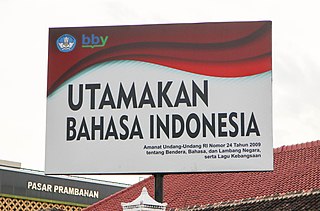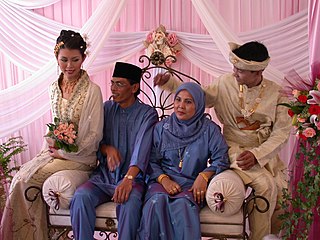Related Research Articles

Orangutans are great apes native to the rainforests of Indonesia and Malaysia. They are now found only in parts of Borneo and Sumatra, but during the Pleistocene they ranged throughout Southeast Asia and South China. Classified in the genus Pongo, orangutans were originally considered to be one species. From 1996, they were divided into two species: the Bornean orangutan and the Sumatran orangutan. A third species, the Tapanuli orangutan, was identified definitively in 2017. The orangutans are the only surviving species of the subfamily Ponginae, which diverged genetically from the other hominids between 19.3 and 15.7 million years ago.

Indonesian, sometimes also known simply as Bahasa in international contexts, is the official and national language of Indonesia. It is a standardized variety of Malay, an Austronesian language that has been used as a lingua franca in the multilingual Indonesian archipelago for centuries. With over 280 million inhabitants, Indonesia ranks as the fourth most populous nation globally. According to the 2020 census, over 97% of Indonesians are fluent in Indonesian, making it the largest language by number of speakers in Southeast Asia and one of the most widely spoken languages in the world. Indonesian vocabulary has been influenced by various native regional languages such as Javanese, Sundanese, Minangkabau, Balinese, Banjarese, and Buginese, as well as by foreign languages such as Arabic, Dutch, Portuguese, and English. Many borrowed words have been adapted to fit the phonetic and grammatical rules of Indonesian, enriching the language and reflecting Indonesia's diverse linguistic heritage.
The following are lists of words in the English language that are known as "loanwords" or "borrowings," which are derived from other languages.

Malay Singaporeans are Singaporeans of Malay ancestry, including those from the Malay Archipelago. They constitute approximately 13.5% of the country's residents, making them the second largest ethnic group in Singapore. Under the Constitution of Singapore, they are recognised by the government as the indigenous people of the country, with Malay as the national language of Singapore.

Jakunpeople or Orang Ulu/Orang Hulu are an ethnic group recognised as Orang Asli of the Malay Peninsula in Malaysia.

Ragunan Zoological Park, formerly and still commonly known as Ragunan Zoo, is a zoo located in the eponymous kelurahan (subdistrict) in Pasar Minggu, South Jakarta, Jakarta, Indonesia. The zoo has an area of 140-hectare (350-acre) and the largest park in Jakarta. The zoo has an aviary and a primate centre, and employs over 450 people. Many of the animals in the zoo are endangered and threatened from all parts of Indonesia and the rest of the world. There are a total of 2,288 animals inside the zoo. Laid out in a lush tropical habitat, rare animals such as crocodile, chimpanzee, gorilla, orangutan, tapir, anoa, sumatran tiger, babirusa, and peacocks are given ample room. The zoo is located in South Jakarta and is easily accessible through the Jakarta Outer Ring Road and TransJakarta Corridor 6 bus.

Betawi, also known as Betawi Malay, Jakartan Malay, or Batavian Malay, is the spoken language of the Betawi people in Jakarta, Indonesia. It is the native language of perhaps 5 million people; a precise number is difficult to determine due to the vague use of the name.

The Lantaka also known as rentaka was a type of bronze portable cannon or swivel gun, sometimes mounted on merchant vessels and warships in Maritime Southeast Asia. It was commonly equipped by native seafaring vessels from the Philippines, Indonesia, Brunei, and Malaysia. Lela and rentaka are known by the Malays as meriam kecil, the difference is that rentaka is smaller in length and bore than a lela. and Lantakas are often called Kanyon in Filipino.

A kora-kora or kora kora or coracora is a traditional canoe from the Maluku (Moluccas) Islands, Indonesia. They are naval boat for carrying men on raids for plunder or for slaves. In Maritime Southeast Asia, raiding for slaves was an honourable way of making a living, and the kora kora was needed for defence against raids as well as for forays. Large kora-kora is called juanga or joanga.

The Senoi are a group of Malaysian peoples classified among the Orang Asli, the indigenous peoples of Peninsular Malaysia. They are the most numerous of the Orang Asli and widely distributed across the peninsula. The Senois speak various branches of Aslian languages, which in turn form a branch of Austroasiatic languages. Many of them are also bilingual in the national language, the Malaysian language.

Indonesia–Madagascar relations spans for over a millennium, since the ancestors of the people of Madagascar sailed across the Indian Ocean from the Nusantara Archipelago back in 8th or 9th century AD. Indonesia has an embassy in Antananarivo, while Madagascar does not have an accreditation to Indonesia. It was announced in December 2017 that Madagascar would be opening an embassy in Jakarta in 2018, however, the embassy was never opened.

Orang Seletar are one of the 18 Orang Asli ethnic groups in Malaysia. They are classified under the Proto-Malay people group, which forms the three major people group of the Orang Asli. The Orang Seletar are also considered as part of the Orang Laut, natives of the Straits of Johor; separating Singapore from Peninsula Malaysia.

The djong, jong, or jung is a type of sailing ship originating from Java that was widely used by Javanese, Sundanese sailors. The word was and is spelled jong in its languages of origin, the "djong" spelling was a colonial Dutch romanization. In English, the jong lends its name to other ships of similar configuration, called junks, and to their characteristic style of rigging, the junk rig.

Orembai or Arombai is a type of plank boat from the Maluku Islands of Eastern Indonesia. It is mainly used for fishing and transport. This vessel is used as far as Batavia, where in the 17th century it became popular to go out "orembaaien" on an evening rowing on the river or city canals.

A juanga or joanga refers to large-sized kora-kora, karakoa and lanong. They are used all throughout the Philippines and Eastern Indonesia, in Maluku smaller versions were popular and are still used to this day (Kora-kora). They are propelled by oars but are not used for carrying cargo.
References
- "Breve diccionario etimológico de la lengua española" by Guido Gómez de Silva ( ISBN 968-16-2812-8)